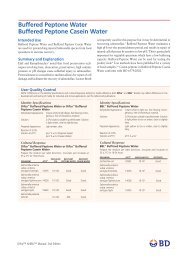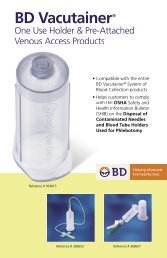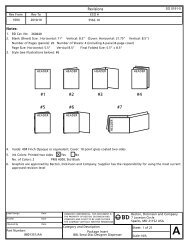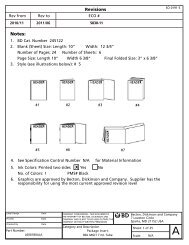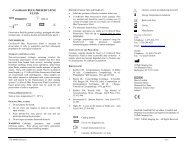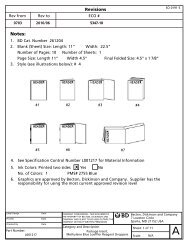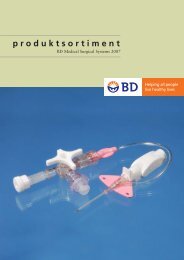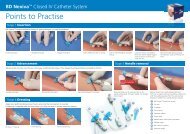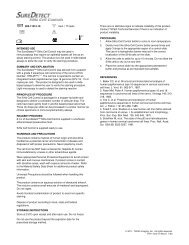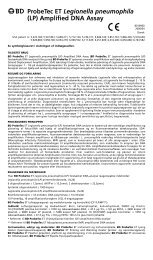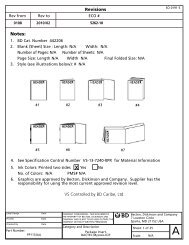Vacutainer® Urinalysis Preservative Plus Urine Tube - BD
Vacutainer® Urinalysis Preservative Plus Urine Tube - BD
Vacutainer® Urinalysis Preservative Plus Urine Tube - BD
Create successful ePaper yourself
Turn your PDF publications into a flip-book with our unique Google optimized e-Paper software.
INTENDED USE<br />
<strong>BD</strong> Vacutainer ® <strong>Urinalysis</strong> <strong>Preservative</strong> <strong>Plus</strong> <strong>Urine</strong> <strong>Tube</strong>s are single use tubes designed for collection, storage and transport of urine<br />
specimens for chemistry dipstick and automated sediment examination for in vitro diagnostic use. The tubes are used in settings where a<br />
urine specimen is collected by a trained healthcare worker.<br />
SUMMARY AND EXPLANATION<br />
<strong>BD</strong> Vacutainer ® <strong>Urinalysis</strong> <strong>Preservative</strong> <strong>Plus</strong> <strong>Urine</strong> <strong>Tube</strong>s are designed for automated and manual chemistry dipstick urinalysis and to<br />
obtain sediment for examination. The preservative allows for transport, testing and storage of the specimen up to 72 hours at room<br />
temperature. The urinalysis preservative is intended to inhibit the metabolism of or render non-viable the bacteria normally present in<br />
urine while maintaining cellular integrity. Without the presence of a preservative, the bacteria continue to metabolize and reproduce,<br />
causing changes in the urine chemistry components measured in a routine urinalysis.<br />
PRODUCT DESCRIPTION<br />
<strong>BD</strong> Vacutainer ® <strong>Urinalysis</strong> <strong>Preservative</strong> <strong>Plus</strong> <strong>Urine</strong> <strong>Tube</strong>s are 8.0 mL draw volume, 16 x 100 mm, with a urinalysis preservative and<br />
<strong>BD</strong> Hemogard Closure with yellow shield color. A minimum fill line of 7.0 mL and a maximum fill line of 9.0 mL is indicated on the<br />
label. The tubes have sterile interiors.<br />
<strong>Preservative</strong><br />
The mean concentration of the preservative in the urine sample in <strong>BD</strong> Vacutainer ® <strong>Urinalysis</strong> <strong>Preservative</strong> <strong>Plus</strong> <strong>Urine</strong> <strong>Tube</strong> is:<br />
Sodium Propionate 94%<br />
Ethyl Paraben 5.6%<br />
Chlorhexidine 0.4%<br />
PRECAUTIONS:<br />
1. Caution should be used in handling the screw cap lid of the <strong>BD</strong> Vacutainer ® <strong>Urine</strong> Collection Cup, which contains a needle under<br />
the label. Treat the screw cap of the cup as a contaminated sharp and discard in biohazard container approved for sharps disposal<br />
as per your facility’s recommended procedure.<br />
2. Caution should be used in handling the transfer straw that contains a needle and should be disposed of as a contaminated sharp<br />
after use.<br />
3. All biologic specimens and devices used to collect or store clinical specimens should be carefully handled and disposed of in<br />
accordance with the precautions recommended by the CDC, CLSI, and your facility’s recommended procedures.<br />
4. If a urine specimen contains blood, all specimen collection devices must be classified as biohazardous for handling and disposal purposes.<br />
5. Do not squeeze cup.<br />
CAUTION:<br />
1. Practice standard precautions. Use gloves, gowns, eye protection, other personal protective equipment and engineering controls to<br />
protect from specimen splatter, leakage, and potential exposure to bloodborne pathogens or other infectious materials.<br />
2. All biologic specimens and devices used to collect or store clinical specimens should be carefully handled and disposed of in<br />
accordance with the precautions recommended by the CDC, CLSI, and your facility’s recommended procedures.<br />
3. Discard all biologic samples in containers approved for their disposal per your facility’s recommended procedures.<br />
4. Transferring a sample to a tube using a syringe and needle is not recommended. Additional manipulation of sharps such as hollow<br />
bore needles increases the potential for needlestick injuries.<br />
5. Transferring samples from syringe to an evacuated tube using non-sharps devices should be performed with caution for the reasons<br />
described below:<br />
• Depressing the syringe plunger during transfer can create a positive pressure, forcefully displacing the stopper and sample, causing<br />
splatter and potential exposure to infectious material.<br />
• Evacuated tubes are designed to draw the volume indicated.<br />
• Using a syringe for specimen transfer may also cause over or under filling of tubes resulting in the incorrect urine to additive ratio.<br />
Filling is complete when vacuum no longer continues to draw, though some tubes may partially fill due to plunger resistance when<br />
filled from a syringe. Consult your facility’s policy and procedure regarding the use of these specimens for diagnostic evaluations.<br />
STORAGE<br />
<strong>BD</strong> Vacutainer ® <strong>Urinalysis</strong> <strong>Preservative</strong> <strong>Plus</strong> <strong>Urine</strong> <strong>Tube</strong>s are stable when stored between 4 - 25˚C and used prior to expiration date.<br />
EN<br />
METHODS OF COLLECTION<br />
Instructions to transfer the specimen into evacuated tube(s) from <strong>BD</strong> Vacutainer ® <strong>Urine</strong> Collection Cup:<br />
1. If the urine specimen is collected in a <strong>BD</strong> <strong>Urine</strong> Collection Cup, the patient is instructed to give the urine specimen to the healthcare<br />
professional immediately after collection. Note: The healthcare professional obtains a cup for the patient and cautions the patient not<br />
to remove the cap label to protect against needlestick from the “sharp” contained in the integrated transfer device.<br />
a. Place cup upright on clean, flat surface. Container may be tipped at an angle if specimen volume is limited.<br />
b. Peel back label on cap to expose the integrated transfer device.<br />
c. Place evacuated tube into cavity on cap, stopper down. Advance the tube over puncture point to pierce stopper. <strong>BD</strong> Vacutainer ®<br />
C&S <strong>Preservative</strong> <strong>Urine</strong> <strong>Tube</strong>s should be filled first when collecting multiple tubes.<br />
2




